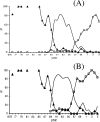Clonal distribution of invasive Neisseria meningitidis serogroup C strains circulating from 1976 to 2005 in greater Sao Paulo, Brazil
- PMID: 17314227
- PMCID: PMC1865849
- DOI: 10.1128/JCM.02510-06
Clonal distribution of invasive Neisseria meningitidis serogroup C strains circulating from 1976 to 2005 in greater Sao Paulo, Brazil
Abstract
Meningococcal disease is characterized by cyclic fluctuations in incidence, serogroup distribution, and antigenic profiles. In greater São Paulo, Brazil, there has been a constant increase in the incidence of serogroup C meningococcal disease since the late 1980s. To gain an understanding of changes in serogroup C meningococcal disease over three decades in greater São Paulo, Brazil, 1,059 invasive Neisseria meningitidis serogroup C isolates from 1976 and 2005 were analyzed. Three major clone complexes, sequence type (ST)-11, ST-8, and ST-103, were identified by multilocus sequence typing, and the isolates were characterized by serotyping and 16S rRNA typing. During the 30-year period, there were two major antigenic replacements: from 2a:P1.(5,2) to 2b:P1.3 and subsequently to 23:P1.14-6. All strains of clone ST-103 were characterized as serotype 23 and serosubtype P1.14-6. The origin of 23:P1.14-6 ST-103 complex strains is unknown, but efforts are needed to monitor its spread and define its virulence. The antigenic replacements we observed likely represent a mechanism to sustain meningococcal disease in the population as immunity to circulating strains accumulated.
Figures

References
-
- Alcalá, B., C. Salcedo, L. Arreaza, S. Berrón, L. De La Fuente, and J. A. Vázquez. 2002. The epidemic wave of meningococcal disease in Spain in 1996-1997: probably a consequence of strain displacement. J. Med. Microbiol. 51:1102-1106. - PubMed
-
- Arhin, F. F., F. Moreau, J. W. Coulton, and E. Mills. 1998. Sequencing of porA from clinical isolates of Neisseria meningitidis defines a subtyping scheme and its genetic regulation. Can. J. Microbiol. 44:56-63. - PubMed
Publication types
MeSH terms
Substances
Associated data
- Actions
- Actions
Grants and funding
LinkOut - more resources
Full Text Sources
Molecular Biology Databases

